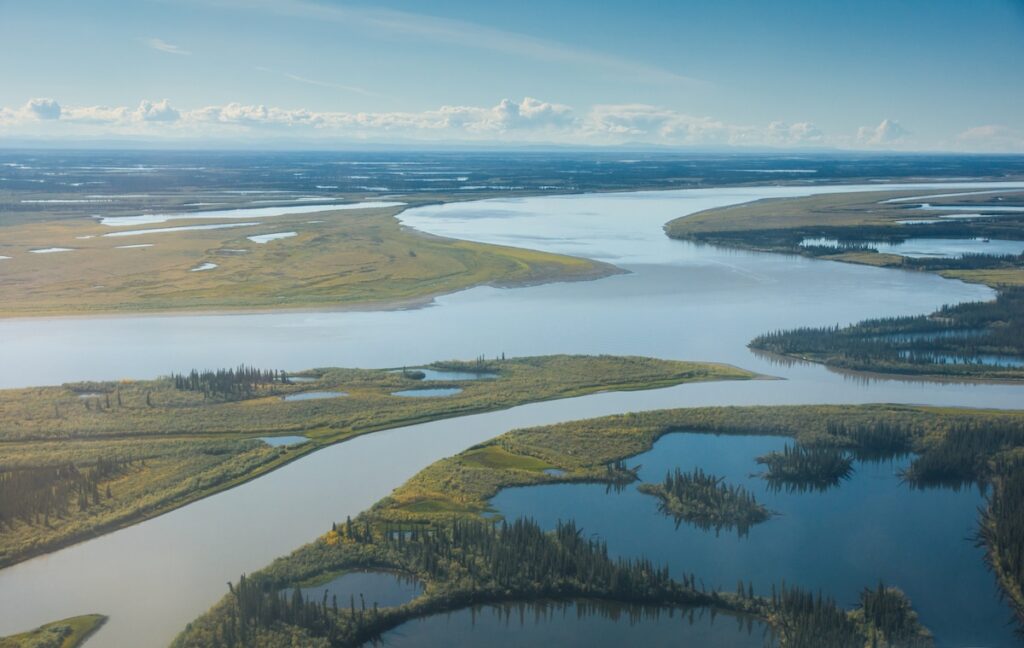Arctic Waters Are Emitting More Carbon as They Warm, Study Finds
4 min read
The Mackenzie River as it nears the Arctic Ocean. eppicphotography / iStock / Getty Images Plus
Founded in 2005 as an Ohio-based environmental newspaper, EcoWatch is a digital platform dedicated to publishing quality, science-based content on environmental issues, causes, and solutions.
The Arctic Ocean may be the planet’s smallest ocean, but it is an important carbon sink that absorbs up to 198 million tons of carbon annually, according to a press release from NASA.
However, a recent study has shown that thawing permafrost and runoff rich with carbon from the Mackenzie River in Canada is triggering part of Earth’s northernmost ocean to release a greater amount of carbon than it absorbs.
“Since the 1970s, the Arctic has warmed three time[s] faster than anywhere else on Earth, inducing large changes in its hydrological cycle. This warming has dramatically altered Arctic watersheds and rivers, which play an important role in shaping the physical and biogeochemical setting of the coastal AO [Arctic Ocean],” the authors of the study wrote. “Recent work shows that permafrost-driven carbon in the Mackenzie River mouth was observed even in early spring/summer, typically when only modern (i.e., young) organic matter has been observed, highlighting the ongoing, rapid Arctic warming.”
The study, “Biogeochemical River Runoff Drives Intense Coastal Arctic Ocean CO2 Outgassing,” was published in the journal Geophysical Research Letters.
The study looks at the ways in which scientists are using computer modeling to examine rivers like the Mackenzie, which empties into the Beaufort Sea, NASA said. In recent years, warmer temperatures have led to more thawing and melting of landscapes and waterways in the Mackenzie River system and its delta.
In this marshy part of the Northwest Territories of Canada, the Mackenzie River serves as a conveyor of minerals and inorganic and organic matter. The material then runs into the Beaufort Sea as dissolved sediment and carbon. Some of the carbon gets released — outgassed — into the atmosphere.
Scientists had previously seen the southeastern part of the Beaufort Sea as a “weak-to-moderate” carbon sink that absorbs more carbon than it releases, but this has been far from a certainty due to the remoteness of the region and a lack of data.
In order to make up for the scarcity of information, the researchers adapted ECCO-Darwin — an ocean biogeochemical model — developed in Southern California at NASA’s Jet Propulsion Laboratory and at the Massachusetts Institute of Technology. The model took almost all available ocean observations that had been collected for over two decades by satellite- and sea-based instruments.
Using the model, the international research team simulated freshwater discharge and its elements — including nitrogen, silica and carbon — from 2000 to 2019.
The team found that such intense outgassing was being triggered by river discharge in the Beaufort Sea that the carbon balance had tipped, causing a net release of 0.13 million metric tons of carbon dioxide annually — about the same as the yearly emissions of 28,000 gas-powered automobiles. There were seasonal variations in the amount of carbon released into the atmosphere, with a greater amount of outgassing in the warmer months when discharge from the river was high and there wasn’t as much sea ice covering and trapping the gas.
However, while some of the changes that have been happening in the warming Arctic since the 1970s have promoted increased regional outgassing of carbon, others have led to greater carbon absorption.
According to NASA, rivers are flowing faster due to more ice and snow melt and the thawing of Arctic lands. As they do so, they flush more organic matter from peatlands and permafrost into the ocean. However, microscopic phytoplankton near the surface of the ocean are also blooming in the expanding areas of open water bathed in sunlight as sea ice shrinks. Like plants, these tiny marine organisms use photosynthesis to capture carbon dioxide, turn it into energy and release oxygen.
While the study was focused on one part of the Arctic Ocean, the findings can help illuminate greater environmental changes happening in the region.
“With our model, we are trying to explore the real contribution of the coastal peripheries and rivers to the Arctic carbon cycle,” said Clément Bertin, lead author of the study and a scientist at France’s Littoral Environnement et Sociétés, in the press release.
Subscribe to get exclusive updates in our daily newsletter!
By signing up, you agree to the Terms of Use and Privacy Policy & to receive electronic communications from EcoWatch Media Group, which may include marketing promotions, advertisements and sponsored content.





